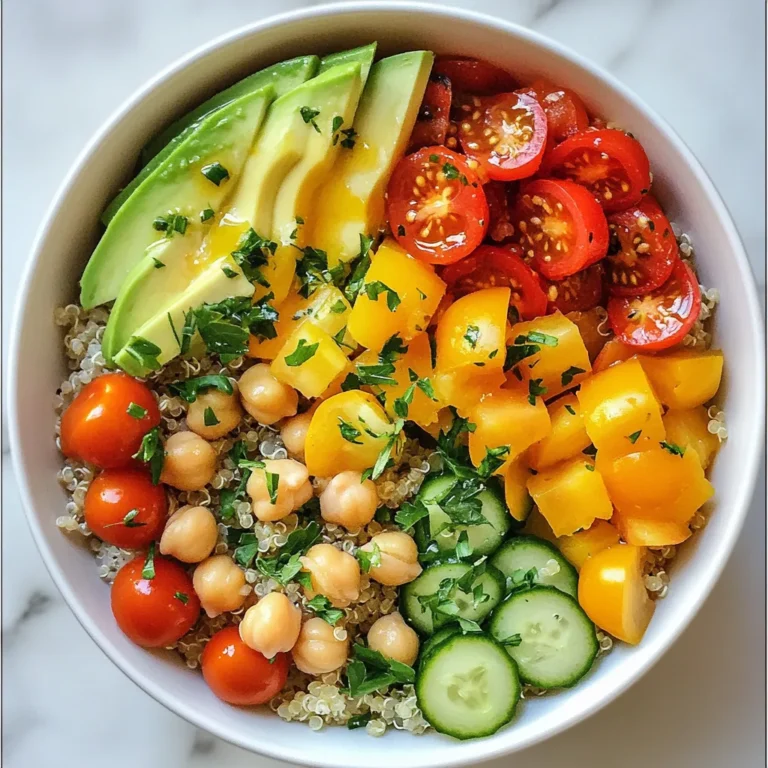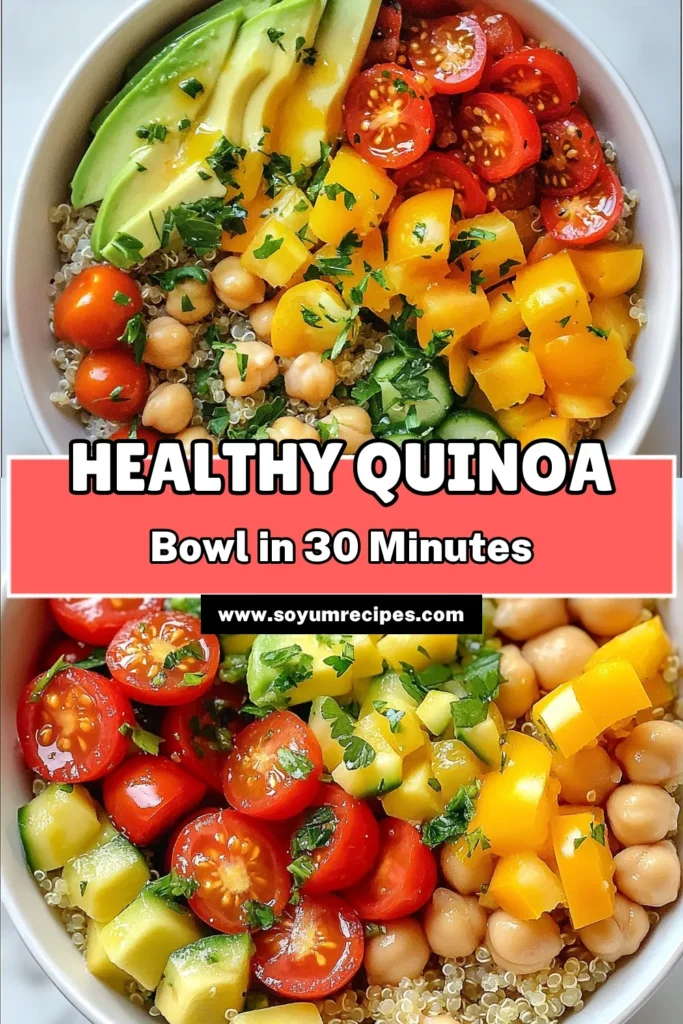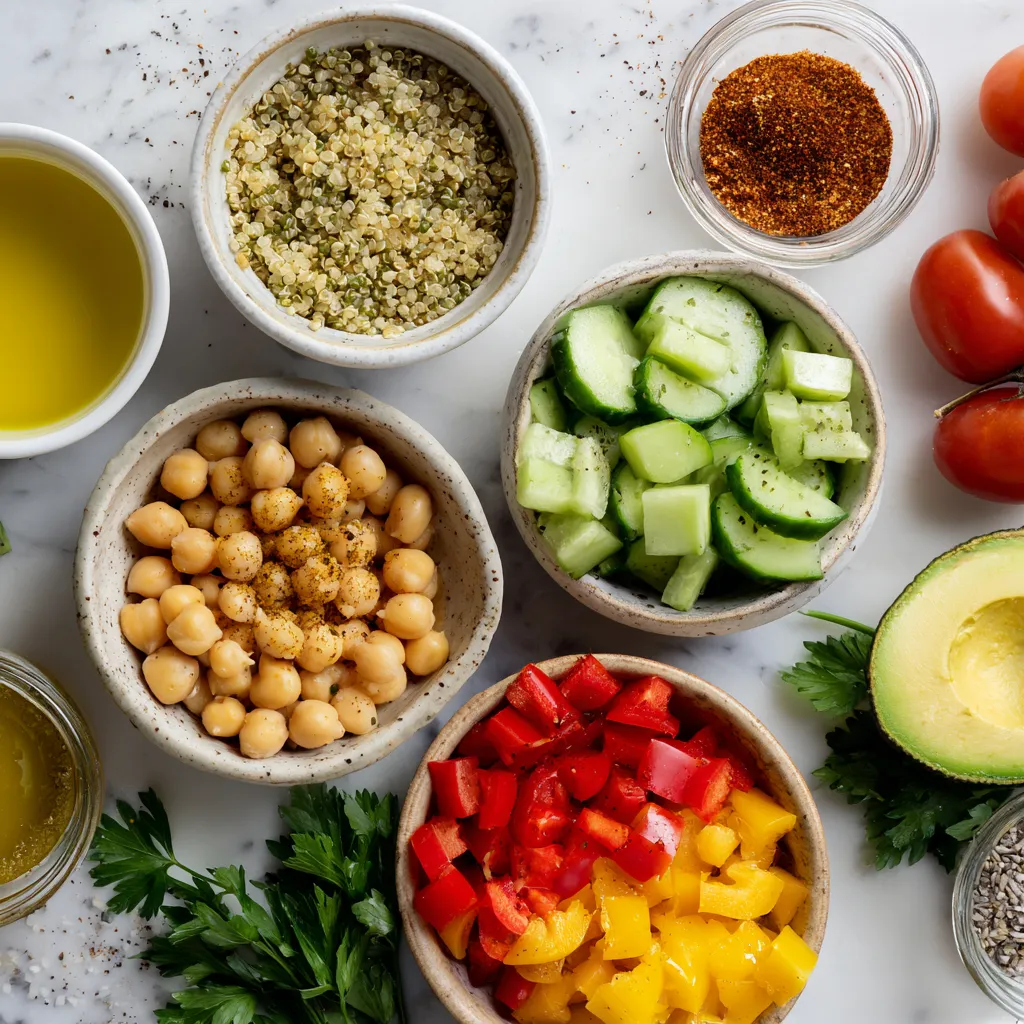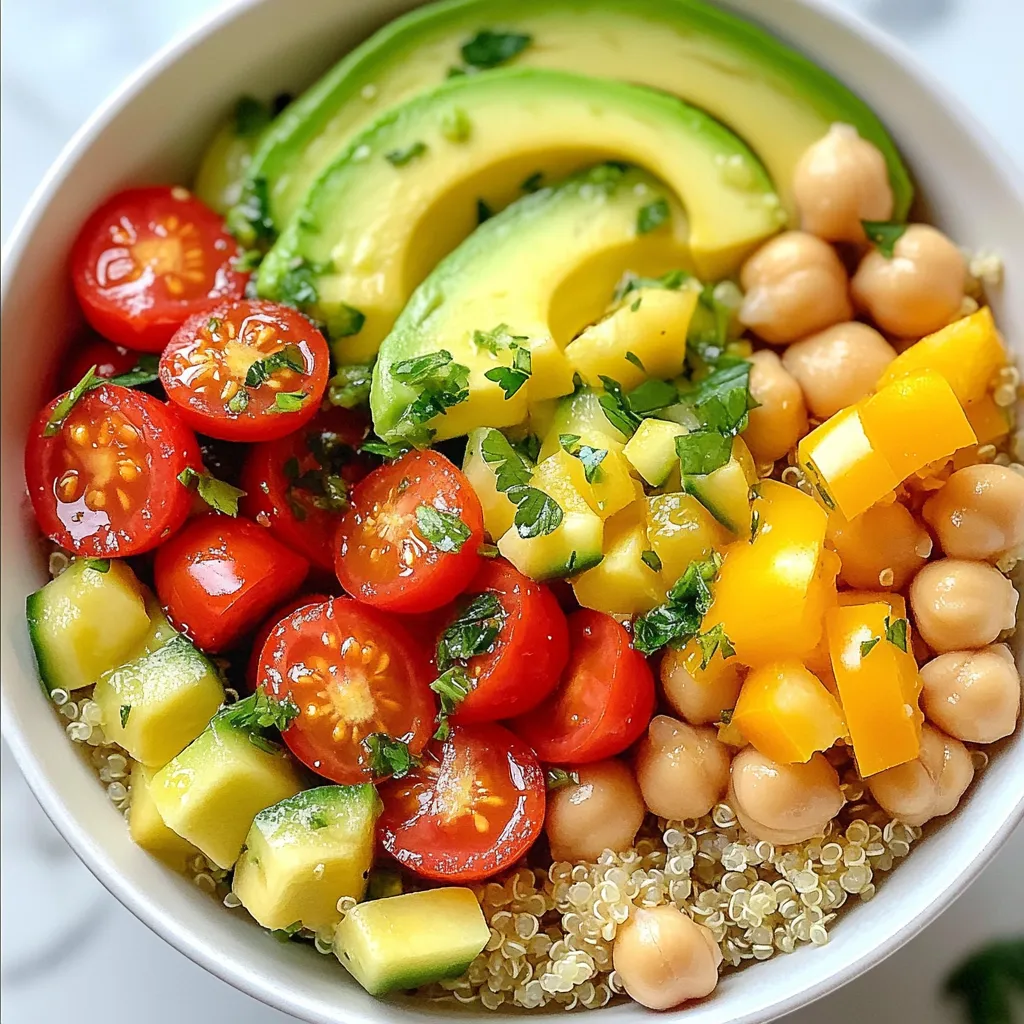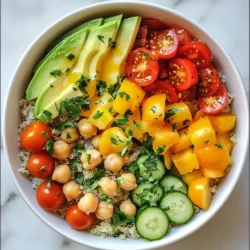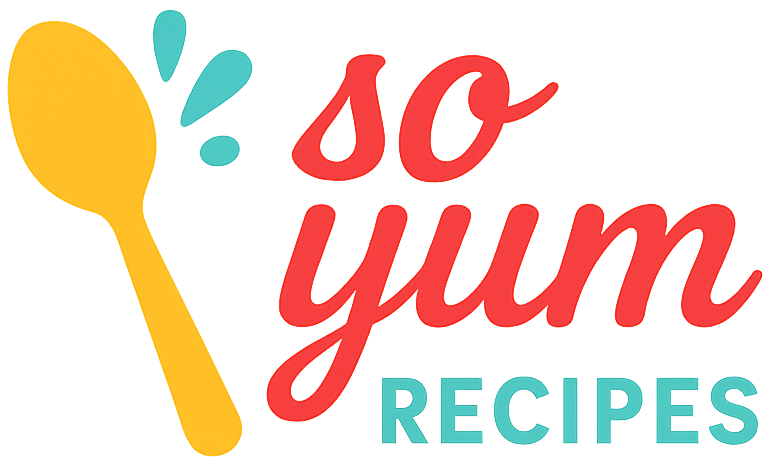WANT TO SAVE THIS RECIPE?
Are you looking for a tasty and healthy meal that fits your diabetes needs? Look no further! This Diabetes Friendly Quinoa Bowl is both energizing and nutritious. Packed with beneficial ingredients, it helps keep your blood sugar steady while satisfying your hunger. I’ll guide you through each step, from cooking perfect quinoa to adding delicious veggies and proteins. Let’s dive into this simple, tasty bowl that you can easily prepare at home!
Why I Love This Recipe
- Healthy Ingredients: This quinoa bowl is packed with nutritious ingredients that are beneficial for managing blood sugar levels, making it a perfect choice for those with diabetes.
- Quick and Easy: With a total preparation time of just 30 minutes, this recipe is perfect for busy weeknights or meal prepping for the week ahead.
- Versatile and Adaptable: You can easily customize this bowl with your favorite veggies, proteins, or dressings, making it a flexible option for any palate.
- Delicious Flavor: The combination of spices, fresh vegetables, and creamy avocado creates a delightful flavor profile that is both satisfying and refreshing.
Ingredients
List of Ingredients with Measurements
– 1 cup quinoa, rinsed
– 2 cups vegetable broth (low sodium)
– 1 cup cherry tomatoes, halved
– 1 cup cucumber, diced
– 1 bell pepper (any color), diced
– 1 avocado, sliced
– 1 cup chickpeas, cooked or canned (drained and rinsed)
– 2 tablespoons olive oil
– 1 tablespoon lemon juice
– 1 teaspoon cumin
– 1 teaspoon smoked paprika
– Salt and pepper to taste
– Fresh parsley or cilantro for garnish
Nutritional Benefits of Each Ingredient
Quinoa is a great source of protein and fiber. It helps keep your blood sugar steady. This grain also has many vitamins and minerals. It is gluten-free and easy to digest.
Vegetable broth adds flavor without many calories. It is low in sodium, which is good for heart health.
Cherry tomatoes are full of antioxidants. They help reduce inflammation and boost your immune system.
Cucumbers are hydrating and low in calories. They help you feel full without adding extra sugar.
Bell peppers are rich in vitamin C. They support your immune system and skin health.
Avocado is high in healthy fats. It helps you feel satisfied and supports heart health.
Chickpeas are a great plant-based protein. They are high in fiber and help manage blood sugar.
Olive oil provides healthy fats. It can lower the risk of heart disease.
Lemon juice adds flavor and vitamin C. It can help with digestion and increase iron absorption.
Cumin and smoked paprika add flavor without extra calories. They also have health benefits like aiding digestion.
Importance of Portion Sizes for Diabetes Management
Portion sizes matter for managing diabetes. Eating the right amount helps control blood sugar. For quinoa, one serving is about half a cup cooked.
Vegetables should fill half your plate. This keeps calories low and nutrients high. Aim for one cup of mixed veggies.
Limit avocado to a quarter for healthy fats. Chickpeas should be about half a cup.
Use the dressing sparingly. Two tablespoons is enough to flavor your dish without extra calories.
Keeping portions in check helps you enjoy this bowl while managing your health.

Step-by-Step Instructions
Cooking Quinoa: How to Achieve the Perfect Texture
To start, rinse 1 cup of quinoa under cold water. This removes the bitter taste. In a medium saucepan, combine the rinsed quinoa and 2 cups of low-sodium vegetable broth. Bring this mixture to a boil over medium-high heat. Once it boils, reduce the heat to low. Cover the pot and simmer for about 15 minutes. You want the quinoa to absorb all the liquid. When done, the quinoa should look fluffy and light. Use a fork to fluff it up gently. Let it cool for a few minutes before mixing it with veggies.
Preparing the Vegetables and Dressing
While the quinoa cooks, it’s time to chop. Cut 1 cup of cherry tomatoes in half. Dice 1 cup of cucumber and 1 bell pepper of any color. If you use canned chickpeas, drain and rinse 1 cup. In a large bowl, mix the tomatoes, cucumber, bell pepper, and chickpeas. Now for the dressing! In a small bowl, whisk together 2 tablespoons of olive oil, 1 tablespoon of lemon juice, 1 teaspoon of cumin, and 1 teaspoon of smoked paprika. Add salt and pepper to taste. This dressing will add flavor to your bowl.
Combining Ingredients and Serving Suggestions
Once the quinoa has cooled, add it to the vegetable bowl. Drizzle the dressing over everything and toss gently. Make sure all ingredients blend well. For a tasty finish, slice 1 avocado and place it on top. You can also garnish with fresh parsley or cilantro. Serve this quinoa bowl warm or cold. It’s a great dish for lunch or dinner. Enjoy your healthy, diabetes-friendly meal!
Tips & Tricks
How to Make the Quinoa Bowl Even Healthier
To boost the health of your quinoa bowl, try adding leafy greens. Spinach or kale adds fiber and vitamins. You can also include nuts or seeds for crunch and healthy fats. Pumpkin seeds or walnuts work well. Consider using a variety of veggies for more nutrients. Roasting them can enhance their flavor. Opt for low-sodium broth to keep salt levels down. This keeps your meal heart-healthy.
Common Mistakes to Avoid When Making Quinoa Bowls
One common mistake is not rinsing quinoa before cooking. Rinsing removes a bitter coating called saponin. Always rinse it under cold water. Another mistake is overcooking quinoa. This can make it mushy. Cook it just until it’s fluffy and the liquid is gone. Adding too much dressing can overpower the flavors. Start with a little, then add more if needed. Lastly, avoid skipping portion control. Even healthy foods can lead to weight gain if eaten in large amounts.
Best Practices for Cooking Quinoa for Blood Sugar Control
When cooking quinoa, use the right water-to-quinoa ratio. A 2:1 ratio of broth to quinoa works best. This helps control the texture. Let the quinoa rest after cooking. This allows it to absorb any remaining moisture. Keep servings small, about half a cup. Pair quinoa with protein, like chickpeas or chicken, to stabilize blood sugar. Lastly, include fiber-rich veggies. These can slow down sugar absorption, helping maintain steady blood sugar levels.
Pro Tips
- Rinse Quinoa Thoroughly: Always rinse quinoa under cold water before cooking to remove its natural coating, saponin, which can impart a bitter taste.
- Customize Your Veggies: Feel free to mix and match your favorite vegetables in this quinoa bowl. Seasonal veggies can enhance both flavor and nutrition.
- Perfect Avocado: To ensure your avocado is perfectly ripe, gently press on its skin. It should yield slightly without being mushy.
- Meal Prep Friendly: This quinoa bowl can be made ahead of time and stored in the refrigerator for up to 3 days, making it a great option for meal prep.

Variations
Protein Variations: Adding Lean Meats or Tofu
You can boost your quinoa bowl with protein. Lean meats like chicken or turkey work well. Tofu is a great plant-based option. Just cube the tofu and sauté it lightly. This adds texture and flavor. Each protein choice helps balance blood sugar and keeps you full longer.
Vegetable Substitutions for Seasonal Ingredients
Feel free to change the veggies based on what is fresh. In summer, add zucchini or bell peppers. In fall, consider roasted squash or sweet potatoes. Seasonal veggies not only taste great, but they also give you different nutrients. You’ll find new favorites by mixing up the vegetables.
Flavor Enhancements: Different Dressings and Spices
You can enhance the flavor with different dressings or spices. Try a tahini dressing for a nutty taste. A splash of balsamic vinegar adds a sweet tang. Experiment with spices like turmeric or coriander. These small changes can make your quinoa bowl exciting and new each time!
Storage Info
Tips for Storing Leftovers
After enjoying your quinoa bowl, store any leftovers right away. Use an airtight container to keep it fresh. This helps to keep out air and moisture. Label the container with the date. This way, you’ll know when you made it.
How Long Can You Keep the Quinoa Bowl in the Fridge?
You can keep the quinoa bowl in the fridge for up to three days. After that, the quality may decline. Always check for any signs of spoilage before eating. If it smells off or looks weird, throw it away.
Freezing Options for Meal Prep Convenience
Freezing is a great way to save your quinoa bowl for later. You can freeze it for up to three months. Divide it into single-serving containers. Make sure to leave some space at the top for expansion. When you’re ready to eat, thaw it in the fridge overnight. Reheat it gently in the microwave or on the stove. This keeps the flavors and texture intact.
FAQs
What is the Glycemic Index of Quinoa?
The glycemic index (GI) of quinoa is about 53. This makes it a low-GI food. Foods with a low GI can help manage blood sugar levels. Quinoa releases sugar slowly into the blood. This keeps your energy steady and helps avoid spikes.
Can I Make This Bowl Vegan or Gluten-Free?
Yes, you can make this bowl vegan and gluten-free. Quinoa is naturally gluten-free, so it’s a great choice. To make it vegan, use vegetable broth and skip any animal products. All the ingredients in this bowl are plant-based. This makes it easy for everyone to enjoy.
How Can Quinoa Help Manage Diabetes?
Quinoa helps manage diabetes because it is high in fiber. Fiber slows down sugar absorption in the body. This helps keep blood sugar levels stable. Quinoa also provides protein, which is important for feeling full. This bowl includes chickpeas, adding even more plant protein. Eating quinoa can lead to better blood sugar control.
This article covered the key ingredients for a healthy quinoa bowl. We explored how each ingredient benefits your health and why portion sizes matter for diabetes. I shared step-by-step cooking steps for perfect quinoa and delicious vegetables. I also provided tips to enhance your dish and avoid common mistakes. Finally, we discussed how to store leftovers and answered some common questions. Remember, making small changes can lead to big health benefits. Enjoy your cooking journey and savor each bit
Diabetes-Friendly Quinoa Bowl
A healthy and nutritious quinoa bowl packed with vegetables and flavor, perfect for a diabetes-friendly diet.
Prep Time 15 minutes mins
Cook Time 15 minutes mins
Total Time 30 minutes mins
Course Main Course
Cuisine Healthy
Servings 4
Calories 250 kcal
- 1 cup quinoa, rinsed
- 2 cups vegetable broth (low sodium)
- 1 cup cherry tomatoes, halved
- 1 cup cucumber, diced
- 1 bell pepper (any color) diced
- 1 avocado sliced
- 1 cup chickpeas, cooked or canned (drained and rinsed)
- 2 tablespoons olive oil
- 1 tablespoon lemon juice
- 1 teaspoon cumin
- 1 teaspoon smoked paprika
- to taste salt and pepper
- for garnish fresh parsley or cilantro
In a medium saucepan, combine the rinsed quinoa and vegetable broth. Bring to a boil over medium-high heat.
Once boiling, reduce the heat to low, cover, and simmer for about 15 minutes or until the quinoa has absorbed all the liquid and is fluffy.
While the quinoa is cooking, prepare the vegetables. In a large bowl, combine the cherry tomatoes, cucumber, bell pepper, and chickpeas.
In a small bowl, whisk together the olive oil, lemon juice, cumin, smoked paprika, salt, and pepper to create a dressing.
Once the quinoa is done, fluff it with a fork and let it cool slightly before adding it to the vegetable mixture.
Drizzle the dressing over the quinoa and vegetable bowl, tossing gently to combine all the ingredients evenly.
Top the quinoa bowl with sliced avocado and garnish with fresh parsley or cilantro before serving.
Feel free to customize the vegetables based on your preference.
Keyword diabetes-friendly, quinoa, salad, vegetarian
WANT TO SAVE THIS RECIPE?
